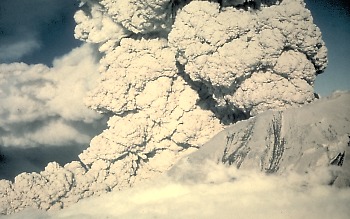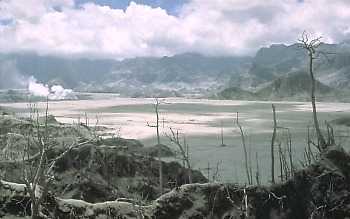
Going with the flow
What is fluid mechanics?

St Helens erupting in 1980. Picture from US Geological Survey
Fluid mechanics is a fascinating part of applied mathematics. One reason why it's so exciting is that it covers the study of both liquids and gases. On the large scale, understanding the atmosphere and the oceans requires techniques from fluid mechanics; on the smaller scale, so does understanding the intricacies of blood flowing through our veins and the propagation of the air we breathe in our lungs. The study of fluid mechanics covers all of these areas, as well as more traditional, engineering-oriented problems, such as describing how water flows in rivers and how the petrol gets to your sparkplug in order to ignite and allow your sports car to roar down the road.

Making models of the weather: Storm evolution. Image from DHD Photo Gallery
At its best, the study of fluid mechanics is performed observationally, theoretically and experimentally. If you're going to make models of the weather, then as well as developing theoretical models and testing them in the laboratory, it's a good idea to actually go outside and make some measurements of rainfall and storm evolution and wind speeds. The theoretical study generally involves differential equations. The reason why differential equations play such a central role is that fluid mechanics, as the word "mechanics" implies, is part of Newtonian mechanics, with its central equation
$$F=ma.$$
As well as saying that the force is equal to the mass times the acceleration, Newton also said that the acceleration is the second derivative of the displacement,
$$a=\frac{d^2x}{dt^2},$$
and so straight away what you have is
$$F=m \frac{d^2x}{dt^2},$$
which is a differential equation.
So what are the forces on the fluids we study in fluid mechanics? There are external pressure forces, but there are also forces that arise due to fluids of different densities acting differently under gravity, and forces due to internal friction, or viscosity as it is called. In the atmosphere, viscosity plays only a rather small and subtle role, but in some other situations, for example when you allow honey to run off your spoon into your porridge, viscosity is very important indeed.
Taking account of all these different forces leads to quite complicated differential equations, with variations with respect to time, and variations with respect to all three spatial dimensions. The resulting differential equations therefore have four independent variables, making them partial differential equations, and are almost always nonlinear in at least some of their terms.
In some very special situations, the solutions are known - but the number of these is very small. For example, you can solve a flow down a smooth straight pipe exactly. But once the flow gets disorganised, or goes round a sharp corner, an exact solution is generally no longer possible.
Solving problems in fluid mechanics

You can't have apples equal to oranges. Image from DHD Photo Gallery
So how do mathematicians solve these complicated differential equations? One approach, which requires a large amount of computing power, is to find approximate solutions to the full equations - known as "numerical solutions". Another approach is to find exact solutions to simplified approximations, which are then tested by comparisons with laboratory experiments and natural occurrences. A method called dimensional analysis plays an essential role in this simplification. The idea of dimensional analysis is that in all equations, the units on the left hand side must match those on the right hand side. You can't do mathematics with apples equal to oranges; you can't have speed equal to height. When you have a whole string of variables they all have their own units, and these can only be combined in certain ways if the equation is to balance. In these simplified models, although you discard a lot of detail, the combination of the variables remains correct, and you can get approximate solutions which tell you how each variable depends on the others. It won't always tell you absolutely accurately, and sometimes you'll have to do an experiment to get one or two constants, but you can go a long way with it. One point in favour of this sort of approximate analysis is that in large scale flows you won't know the exact values of all your variables anyway, so there is already a limit to how accurate you can be.
A typical problem studied in theoretical fluid mechanics is: given all the initial conditions of a situation (a volcanic eruption, pollutant release, etc.), what is the final distribution of the deposit on the ground? A more difficult question, but one whose answer is needed to interpret the deposits of ancient eruptions, is: given only the final distribution of the deposit on the ground, what can be inferred about the size, intensity and duration of the event?
Gravity currents

A gravity current waiting to happen. Image from DHD Photo Gallery
One particularly interesting area of fluid mechanics is the study of gravity currents. These happen when fluid of one density flows into fluid of another density. So when a cold burst of air - and because it's cold, it's heavy - flows into the bottom of the atmosphere, that's a gravity current. If you pour oil onto water, the relatively light oil spreads out over the top of the water, moving the relatively heavier water aside; if your sink overflows and water pours onto the floor, pushing the lighter air aside - these are gravity currents. On the larger scale, sea-breeze fronts are gravity currents. These occur approximately twenty times a year in Britain, when the weather conditions are right. These winds propagate across the country in the afternoon due to the heating of the sea by the sun, and they can travel hundreds of miles. Birds can use them to take the effort out of flying, and they're wonderful for hang-gliding. In Canberra, the capital of my own country, Australia, these sea breezes occur in a predictable manner about three hundred days a year.
Gravity currents occur in a whole range of natural and industrial situations. The word "gravity" refers to the difference in density between the two fluids. (Recall that the specific gravity of a fluid is a measure of its density.) This density difference can be caused in lots of different ways. In the atmosphere it's almost totally due to differences in temperature. In the laboratory, we often use dissolved salt, and put salty water into pure water, and see how the heavier salty water propagates along the bottom of the pure water. Or we can use alcohol, which is less dense than water, and let it flow over the top of the water and displace it downwards.
Particle-laden gravity currents
A density difference can also be caused by small suspended particles. This can introduce an interesting additional effect, because over time these particles can fall out of suspension, changing the density of the fluid. This is a major difference from simple laboratory experiments with dissolved salt, where we know the density of the salt water and it doesn't change over time.
Why are particle-laden gravity currents, as these flows are called, interesting? Again there are lots of natural and industrial examples. For example, when an industry releases pollutant-enriched waste into a lake, we might want to know how far the pollutants will travel. This is a particle-laden gravity current because the pollutants are heavier than the lake water, and may fall out of suspension as the waste flows along. Another example is sewage which hasn't been totally purified. It will be of a different density to the surrounding water, and some of the little flocks suspended in it will fall out of suspension as the sewage travels away from the outlet.

The devastation wrought by the eruption of Mt. Pinatubo. Picture from the US Geological Survey
In the natural world, volcanic eruptions can cause gravity flows. Volcanoes don't just emit lava; they also spew out hot gas containing lots of little ash and dust particles into the atmosphere. The heat tends to make the gas lighter than the surrounding atmosphere, but the particles tend to make it heavier, so in some eruptions the heat wins out, in others, the particles. If the concentration of ash particles is sufficiently high, the result is a ground-hugging gravity current, called a pyroclastic flow. Pyroclastic flows can be at temperatures as high as 8000C, and the biggest ones can travel as fast as 1,000 kilometres an hour. Even the smaller ones, for example, those that have occurred frequently at Montserrat in recent times, travel faster than a person can run.

A pyroclastic flow at the eruption of St Helens in 1980. Image from the US Geological Survey, taken by J. W. Vallance
If the particulate concentration is not sufficient to keep the pyroclastic flow attached to the ground after some of the particles have been deposited, the resulting hot flow can become less dense than the surrounding, colder air and will then suddenly rise vertically, ascending many kilometres into the atmosphere. This form of subsequent motion, known as a co-ignimbrite cloud by geologists, occurred to the pyroclastic flow resulting from the Mt. St. Helens eruption in 1980 after it had propagated a distance of about 18 kilometres. A number of witnesses reported that they saw the pyroclastic flow approach them and they were prepared for the worst when it suddenly lifted off the ground. They did not know (or care?) about the scientific explanation, but were all very grateful at the outcome.
The other thing that can happen with a volcanic eruption, if the concentration of ash particles isn't high enough to cause a pyroclastic flow, is that a column of hot, ash-laden air can shoot up into the atmosphere. In a big volcanic eruption, these columns can travel as high as 45km. At such a height the air in the volcanic plume will no longer be less dense than the surrounding atmosphere.
Initially it was less dense, otherwise it wouldn't have gone up in the first place, but the density of the atmosphere gets less and less as you go up, which is why it becomes more difficult to breathe when you climb tall mountains. When the density of the column matches that of the surrounding air, the flow intrudes into the atmosphere, so you get lots of little ash particles carried around the
earth by the atmospheric winds. A nice consequence is that it makes for beautiful sunsets. For example, when Mt. Pinatubo in Indonesia went up in 1992, there were fabulous sunsets around the world for about two years afterwards. After a big eruption like Krakatoa, there were probably wonderful sunsets for the next ten years or so.

After the eruption of Mt Pinatubo, there were beautiful sunsets all round the world. Image from DHD Photo Gallery
Another major example of a particle-driven gravity current in the natural world occurs when a storm, or the collapse of part of a coastline, suddenly causes there to be huge bits of silt and sand suspended in the ocean. If the amount of suspended material is great enough, such flows can be taken right across oceans, and can cause a lot of trouble. One of these so-called turbidity flows broke the telephone cables between the UK and the US in 1928. Another reason for studying turbidity flows is that they spread a special layer of impervious silt across the bottom of the ocean that can act as a trap for oil, which means that oil companies are fascinated by them.

An infamous pyroclastic flow. Image from DHD Photo Gallery
Aside from natural events, a very tragic example of a pyroclastic flow is what happened on the 11th of September, 2001. Huge amounts of rubble were brought up into the air as the Twin Towers collapsed, the rubble-laden air was heavier than the surrounding air, and it propagated down the streets of New York very rapidly. Some people died as a result of asphyxiation many blocks away, because people's lungs can't cope with very many particles in the air they breathe. From the point of view of fluid mechanics, the questions that were of interest were how quickly the concentration of particulates would decrease, and also how far would the flow travel. It didn't go all the way to Upper Manhattan, but it did go quite a way.
The final frontier?
Related to gravity flows are so-called granular flows - rockfalls are an example. The "grains" can be large - for example, big rocks - or small - for example, grains of maize or corn or hops. A city boy like me can't tell the difference between these different grains just by looking, but they all behave differently when they flow out of a silo, and the silos have to be designed differently for different grains. Studying granular flows is an area where solid and fluid mechanics come together.
A false colour image of a volcano on Io. Picture courtesy of NASA
All the examples of gravity currents described above were on this planet, but they also occur on other planets, as do granular flows. For example, there are volcanic eruptions on Io (one of Jupiter's moons), and we know that on Mars and on our moon there have been gigantic rockfalls. By using the simplifying methods of dimensional analysis it is possible to create a description of how these rockfalls behave. These models can be tested against data from Montserrat, where there have been rockfalls due to volcanic eruptions. On Montserrat, the rockfalls involve volumes of the order of a fraction of a cubic km of rock, whereas on Mars they involve volumes of about 100 cubic km. It would be nice to know much more about these granular flows - it's an exciting area which is close to the study of gravity flows, and there are lots of problems there I can think of to which I'd like to know the answer.
About the author

Herbert Huppert is Professor of Theoretical Geophysics and Director of the Institute of Theoretical Geophysics at the University of Cambridge.